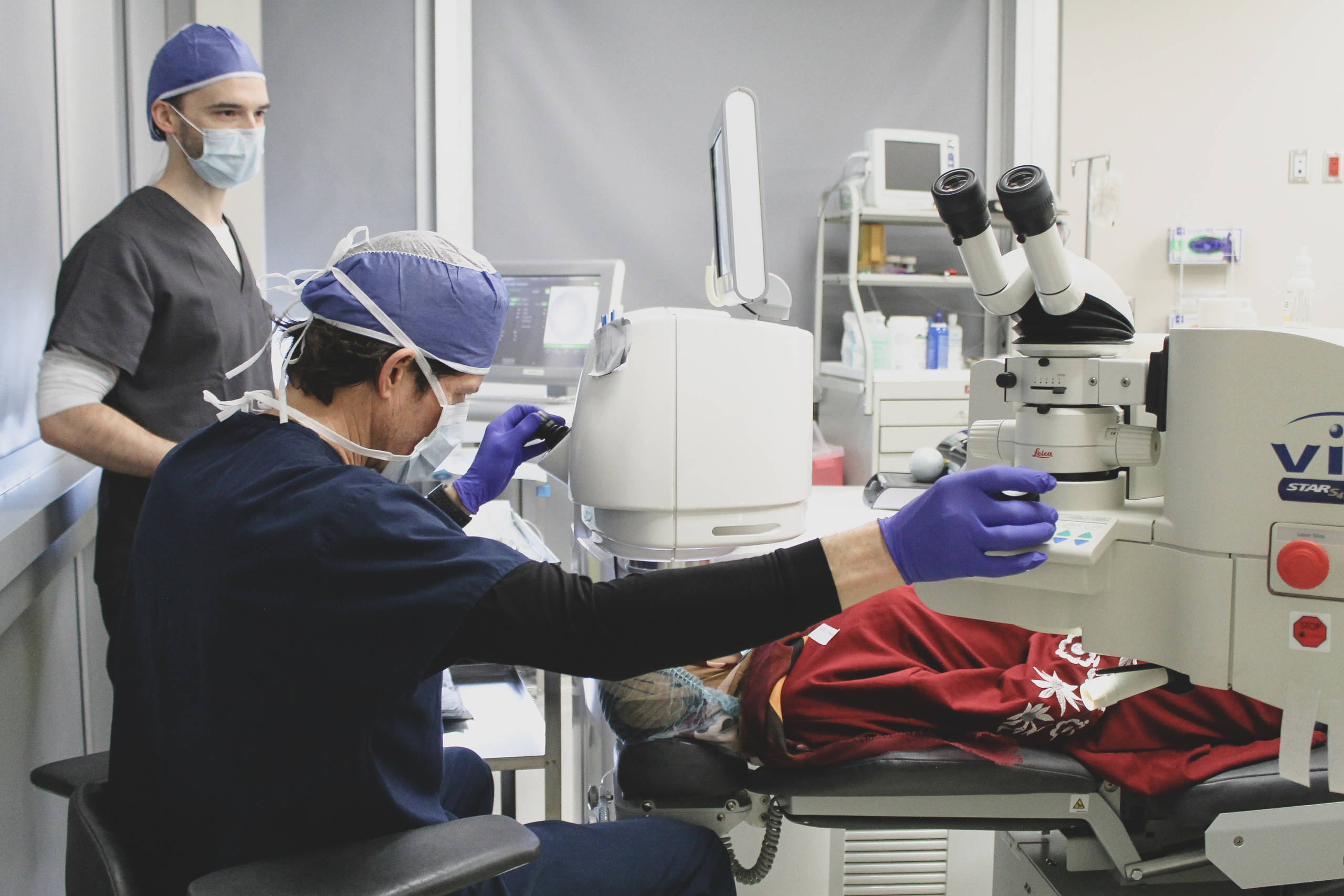Having good eyesight is crucial if you want to maximise your standard of living. PRK (photorefractive keratectomy) is a form of refractive laser eye surgery procedure that can correct nearsightedness, farsightedness, and astigmatism, and is performed on an outpatient basis.
One month following surgery, approximately 80% of patients see better eyesight, and by three months, almost 95% do so.
What is Photorefractive Keratectomy (PRK)?
When it comes to correcting vision, laser eye surgery medical procedure, and more especially refractive laser surgery, the name “photorefractive keratectomy” (PRK) is the one to remember. A refractive error occurs when the eyes fail to appropriately bend light, preventing normal vision.
After PRK, some patients report that they no longer need corrective lenses at all, while others report that they need them just for certain tasks, such as reading or nighttime driving.

The Primary Reason for PRK Surgery is to Correct Refractive Errors
If you suffer from refractive problems, your eye doctor may recommend a photorefractive keratectomy. This technique uses a laser to alter the cornea’s shape, which better concentrates light on the retina. If you’ve been told that you need corrective surgery for one of these common eye conditions, a PRK procedure may be in order:
- Myopia (nearsightedness).
- Hyperopia (farsightedness).
- Astigmatism (the form of your eye produces fuzzy vision) (the shape of your eye causes blurry vision).
Who is a Good Candidate for Photorefractive Keratectomy (PRK)?
To qualify for a PRK, you must meet specific criteria. You should talk to your laser eye doctor (ophthalmologist) about what to expect, but you should also:
- To possess corneas in good health.
- Maintain good eye health.
- Think carefully about what you hope to accomplish with PRK. Your doctor will go over the benefits and risks of the procedure with you.
- You need to be 18 or older to join.
- Keep your eyeglass or contact lens prescription consistent throughout the course of a year.
If you have advanced glaucoma, you probably won’t be a candidate for a PRK procedure.

- Currently nursing.
- Experience cataracts.
- Ail from a condition affecting the eyes, such as a virus, dry eye, or blepharitis.
- Your eyes are scarred.
- Possess a fluctuating refractive error.
- Have a problem with your corneas, whether through injury or illness.
- Suffer from a condition that hinders recovery, such as an allergy or uncontrolled diabetes.
What Kind of Hospitalisation is Required for a PRK Procedure?
Your outpatient laser eye surgery Sydney centre is where your photorefractive keratectomy will take place.
What sort of doctor or surgeon does a photorefractive keratectomy (PRK)?
During your photorefractive keratectomy procedure, you may collaborate with more than one specialist:
- Ophthalmologists (who study and treat eye ailments)
- Eye doctors and surgeons.
- Nurses.
- Optometrists (healthcare specialists that specialise in the eyes in general) (healthcare providers who specialise in the eyes in general).
- Technicians.
When Comparing PRK and LASIK, What Are the Key Distinctions?
For those interested in laser eye surgery, LASIK (laser-assisted in situ keratomileusis) is another option that treats the cornea. The cornea is not flapped like it is during LASIK surgery during a PRK.
If you have dry eyes, a thin cornea, or lead an active lifestyle, PRK may be the best option for you. Activity may cause movement of the corneal flap.

The cornea, the transparent covering of the front of the eye, is the target of all laser vision correction procedures since it is where light entering the eye is focused onto the retina. In PRK, the cornea is reshaped by a laser under the supervision of an ophthalmologist.
In contrast to LASIK, which involves cutting a flap in the cornea and directing a beam of ultraviolet light beneath it, this laser is applied directly to the cornea’s surface.
The healing time and discomfort associated with LASIK are both significantly lower. Patients who undergo PRK are more likely to experience temporary blurred vision. Long-term results from PRK are often on par with those from LASIK.
Considerations that may lead you to choose for PRK instead of LASIK include:
When compared to PRK, LASIK is a more recent treatment.
- A photorefractive keratectomy is a surgical procedure used to correct refractive errors in the eye and is probably more acquainted to your ophthalmologist. Find out how much training your eye surgeon has had by asking them.
- Dislocation or movement of the flap can occur during LASIK surgery. Pilots, athletes, and anyone else who regularly puts their eyes through a lot of motion may choose a PRK because it doesn’t involve a flap that can be shifted by exertion.
Dangers / Advantages
Can you tell me about the benefits of having a PRK done on your eyes?
Before undergoing PRK (photorefractive eye surgery), discuss the procedure’s potential benefits and drawbacks with your doctors. A few of the benefits are as follows:
- Correcting myopia with PRK has been very successful. After one year, roughly 90% of PRK patients can see 20/20 without the aid of corrective lenses. An overwhelming majority can see clearly at 20 feet or more (without glasses or contacts).
- Patients with thinner corneas or corneal surface irregularities may benefit more from PRK than LASIK because PRK damages less corneal tissue than a comparable LASIK procedure.
- While both LASIK and PRK use cutting-edge laser treatment equipment, PRK is technically less complex. It is for this reason that PRK is favoured by some refractive surgeons over LASIK.
Can You Tell Me About the Photorefractive Keratectomy (PRK) Procedure’s Drawbacks, Dangers, and Potential Side Effects?
Risks are always present with every surgical procedure, and photorefractive keratectomy is no exception. You can experience the following side effects after the procedure:
- Corneal scars.
- Cloudiness of the cornea, also known as corneal haze.
- A bacterial or fungal infection.
- Light pollution, especially at night, causes eyestrain and visual discomfort.
- Redness, itching, and/or watering of the eyes.
- a sensitivity to ambient light.
- Having trouble seeing clearly. In some cases, surgeons will administer mitomycin C during PRK procedures to lessen the likelihood of post-operative haze.
- Decrease in response to treatment, also known as regression.
- Completion of recovery postponed.
There have been extremely rare cases of patients experiencing decreased LASER eye vision or even blindness.
Due to differences in wound healing, the outcome is not totally predicted, and some patients may still need corrective lenses or subsequent surgery to see clearly.
Conclusion
Personal Eyes’ mission is to provide information to everyone interested in learning how to better their eyesight. And if you are seriously considering laser eye surgery, you need first ensure that you are a suitable candidate.
If you are having any question or inquiry about how to have a correct vision, Laser eye surgery, Contact lenses, Corneal tissue problems, Lasik surgery, laser eye surgery procedures, laser eye surgery cost, refractive laser eye surgery, laser treatment, advanced surface laser ablation, glasses prescription, blurry vision, the surgical procedure for refractive surgery or Lasik laser eye surgery – you should get in touch with us via our Personal Eyes website to book your free assessment today.



